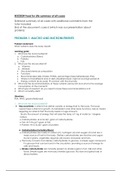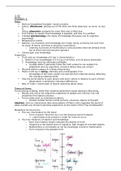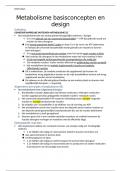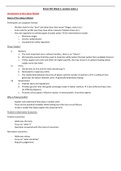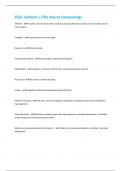SUMMARY
Rosa Craane
CC2007 | 2023
,Week 1: Introduction: what is aesthetics?
Historical roots of aesthetics
Until mid-1700s
- Thinking about art as old as philosophy
- Medieval and renaissance authors discussed the nature of art and beauty.
o Philosophical theology
o Neo-platonic theory
- In the renaissance further development of art theory at academies
- However: aesthetics NOT see as an independent philosophical discipline
18th century
- Establishment of aesthetics as independent as a philosophical discipline
o autonomization of art (enlightenment)
o Consequently: The crisis of aesthesis norms
o Emergence of modern sciences
> Growing out of and against Enlightenment: Romanticism & Bildung
- Alexander Gottlieb Baumgarten
o Used ‘aesthetics’ for the first time as ‘science of sense knowledge.’
▪ Derived from Greek > sense perception.
o Against traditional focus on reason in philosophy > against Enlightenment
o Scientific approach: establish the rules of artistic and natural beauty from
individual taste >out of Enlightenment.
What is aesthetics?
- Aisthesis: the science of sense perception > until the mid-1700s
- Aesthetics: a systematic study of aesthetic judgment> mid-1700s onwards
- Philosophy of art: critical reflection on the nature of art > late- 1700s onwards
- Current interest in aesthetics
o Last decades: philosophy of art and its renaissance
o Developments within modern art: avant-garde art, conceptual
o Developments within philosophy: postmodernism, the ‘end of art’, crisis of
legitimacy
o Most current discussions:
▪ Art beyond the End of art: Form Postmodernism to post-
postmodernism (metamodernism)
▪ Participatory turn in contemporary art: artis as a sociologist, yet what
about aesthetics?
▪ Art-based research: use of tools from the arts and humanities in social
sciences
- Philosophy of art vs. sciences
o Distinction: empirical vs. philosophical questions
o Art historical approach
Art history:
▪ What technical means were used to reach the effect that the work
has?
AESTHETICS -SUMMARY | By Rosa Craane
, ▪ To what extent did the artist deviate from the mainstream norms of
the time?
▪ How does thus the depiction of war scenes fit in the history of war
scenes?
Philosophy:
▪ Should war scenes be portrayed?
▪ Are we able to perceive the emotion of the artist about the war
through this work of art?
o In short:
▪ The difference is determined formally, not materially.
▪ Aesthetic judgments are always normative statements.
▪ Philosophical question transcends empirical observation.
- Philosophy of art vs art criticism:
o 3 similarities
▪ Both disciplines are normative by nature
▪ Aesthetics are in the development of their theory often determined by
their taste.
▪ Aesthetic judgments in art criticism often rely in aesthetic theory.
o Principal distinction: the (art criticism) vs. the general (aesthetics)
- New meanings
o The underlying factor that contributes to aesthetic experience > experimental
aesthetics > science
o The systematic study of stylistic and expressive elements, such as composition
and style> criticism
o The various ways that **beauty** can be studied, both experience and
perception of beauty

